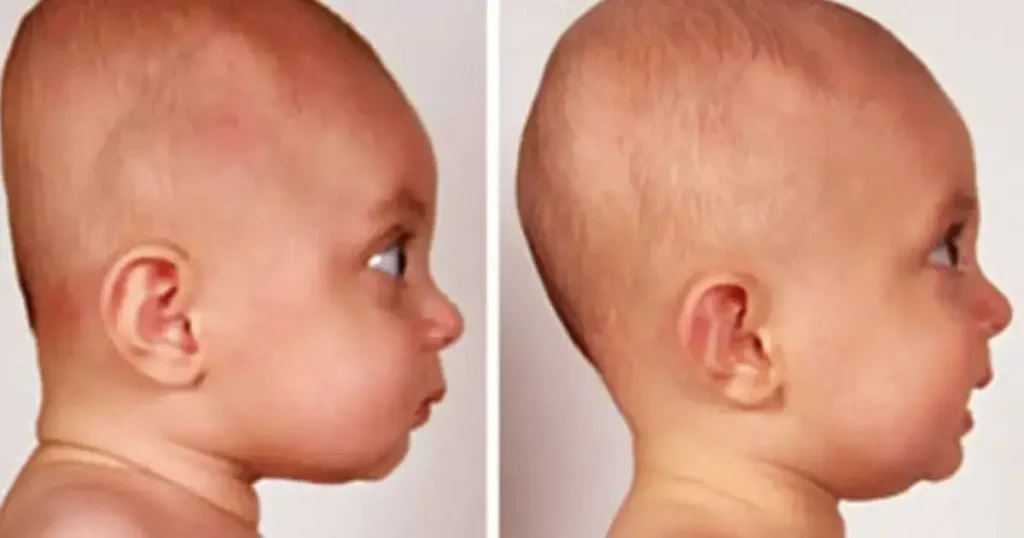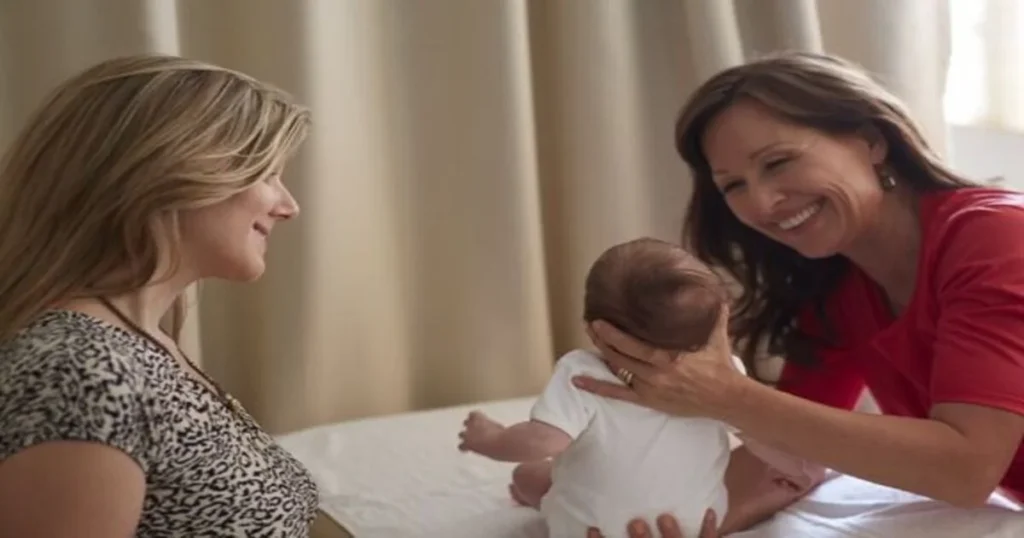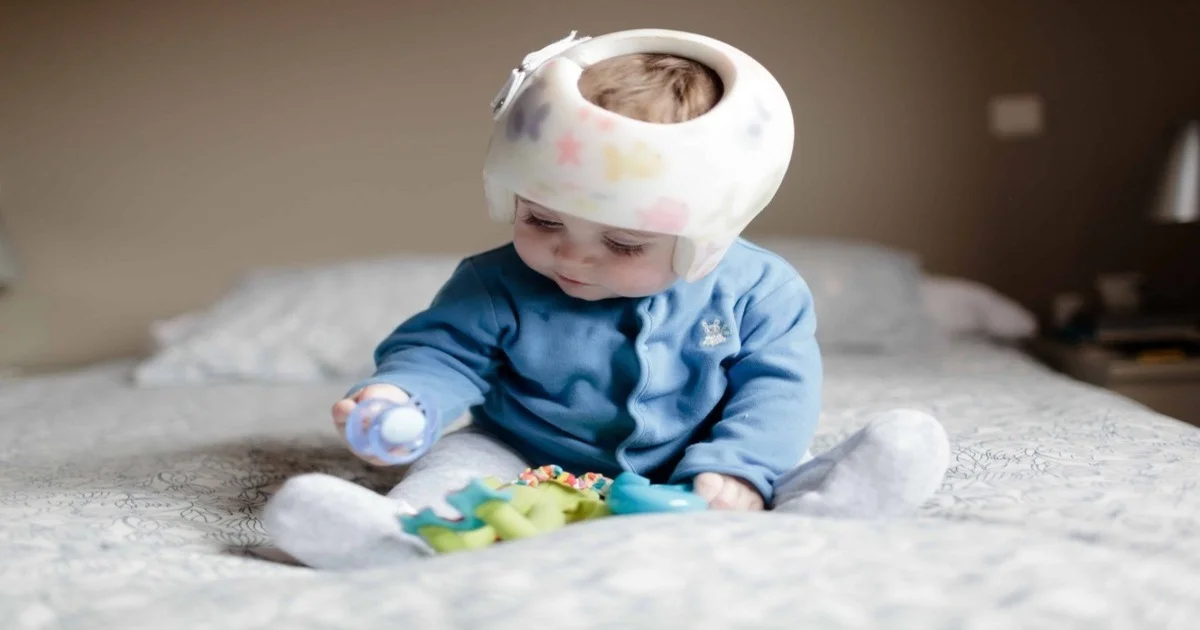It can be worrying for parents to notice their baby developing a flattened or misshapen head. While helmets are an option, many parents wonder – how can I fix my baby’s flat head without a helmet? The good news is there are effective techniques to treat and prevent flat head syndrome without resorting to helmets if addressed early.
What Causes a Flat Head in Babies?

There are a few key causes of flat head syndrome or plagiocephaly in infants:
- Limited head position – Always lying in the same position flattens that area
- Back sleeping – The back of the head flattens from pressure on a firm mattress
- Premature birth – Softer skull bones are more malleable
- Multiple births – Crowded womb may cause head molding
- Developmental delays – Baby lacks strength to move head around
Understanding the cause helps determine the best treatment approach. For instance, frequent head repositioning works for a baby who always favors one side. Physical therapy exercises can help strengthen neck muscles if weakness contributes to the flat spot.
What Are Signs of Flat Head Syndrome?
Look for these signs that may indicate flat head syndrome:
- Flattened area on one side or back of head
- Head appears misshapen or asymmetrical
- Bald spot or protrusion on one area of the head
- Head consistently leans to one side
- Delayed rolling over or trouble alternating head position
Bring up any concerns about head shape at well-baby checkups. Early action leads to the best results.
Can a Baby’s Flat Head Correct Itself?
Mild flattening often corrects itself gradually:
- As neck muscles strengthen, a baby naturally moves their head more
- Once mobile, pressure is relieved from constant back or side sleeping
- As the skull bones grow and fuse, the head rounded out
- Hair growth camouflages mild flattening
But moderate or severe cases need intervention to avoid permanent asymmetry. Consistently repositioning early on enhances rounding.
Pediatrician Recommendations for Treating Flat Head
Most pediatricians advise these steps for treating mild to moderate flat head:
- Increase “tummy time” daily to build strength
- Reposition the head when lying down
- Limit time in car seats, swings and carriers
- Alternate which arm you hold the baby in when feeding/carrying
- Opt for babywearing versus strollers/carriers when possible
- Consider physical therapy if needed to improve strength
Helmets are usually only recommended in severe cases when other approaches fail. Most infants respond well to conservative measures.
Lifestyle Tips to Fix Flat Spots Without a Helmet

Here are tips to incorporate at home every day to help round out your baby’s head naturally:
Reposition the Head Frequently
- Shift the head direction each time you lay baby down. Alternate sleeping right side, left side and stomach.
- Turn the head when carrying or holding baby. Switch which shoulder you support the head with.
- Vary which end of the crib you place baby down – rotate nights sleeping on right side and left.
- Reposition head when in bouncers, strollers and carriers.
Increase Tummy Time and Activity
- Do tummy time 3+ times a day starting as early as possible.
- Limit time in containers like swings, bouncers and car seats.
- Hold and interact with baby upright often through the day.
- Try babywearing in a carrier to reduce container time.
- Check for torticollis and seek physical therapy if needed.
Monitor Sleep Habits
- Use firm, flat sleep surfaces. Avoid pillows, nests and plush bedding.
- Alternate which direction baby sleeps in the crib each night.
- If always sleeping in same spot, rotate the crib against the wall.
- Stop swaddling once showing signs of trying to roll over.
Being diligent with repositioning and activity pays off. Most babies show improvement within a couple months.
Exercises to Help Fix Flat Spots
Targeted exercises build neck strength so a baby naturally moves their head more:
Tummy time – Have baby lie on stomach propped on forearms. Limit to a few minutes at first, increasing gradually. Use mirrors or toys to motivate.
Touch exercises – Hold interesting toys on one side to encourage turning the head. Slowly move toy to encourage following.
Push-ups – With baby lying on stomach, firmly hold shoulders and allow to push up trunk with arms. Builds strength.
Rolling – Roll baby from back to side, then stomach. Gradually increase distance rolled.
Relax head – Hold baby facing you. Gently bend forward, relax and stretch baby’s neck.
Bicycle legs – With baby on back, gently bend/unbend legs one at a time like pedaling. Helps strengthen core.
Do these moves playfully several times a day. It strengthens muscles while providing bonding time.
Using Positioning Aids Without Helmets
Some simple positioning aids help maintain optimal head shape:
- Head pillows – Special pillows with a center indent to avoid pressure on flat spots. Allow room to turn head.
- Crib wedges – Wedges along side of crib encourage sleeping with head turned to rounded side.
- Roll pillows – Small firm pillows to tuck along back or side while lying to encourage turning head.
- Car seat inserts – Pads or rolls put on one side of car seat to make baby turn the head away from the flat spot.
These are temporary aids used in combination with active repositioning. Check safety guidelines before attempting.
When to Consult a Doctor About Flat Head Correction

See a pediatrician promptly if you notice these signs:
- Head flattening emerging at a very young age (under 2 months)
- Misshaping rapidly worsening over 2-4 weeks
- Torticollis or neck tightness limiting movement
- Not improving after diligently trying repositioning for 2 months
- Signs of developmental delays like lack of strength to lift head
Your doctor can assess if a helmet or other treatment is needed. But most cases improve with early conservative care.
Conclusion
Noticing flattening of your baby’s head is understandably worrying. But in most cases it can be corrected without helmets through simple repositioning techniques and neck strengthening exercises. Remaining diligent with these methods starting early usually allows the head to round out over time as the baby naturally begins moving more.
Working closely with your pediatrician allows assessing improvement at regular visits. They will advise if more aggressive intervention is needed. But typically a flat spot improves gradually with basic lifestyle measures. Consistency is key for effectively fixing flat spots without requiring helmets.
Frequently Asked Questions About Fixing Flat Head in Babies.
Does flat head affect brain development?
No, most flat spots are a cosmetic issue only. They do not impact brain growth or development.
How long does it take to fix flat head without helmet?
Allow at least 2-3 months of repositioning and strength building to see improvement. Mild cases can fully self-correct in 4-6 months.
Can flat head be fully corrected after 6 months old?
The younger the better for correction. But improvement can still be achieved through around 12 months with diligent repositioning and activity.
Does flat head affect sleep?
No, there are no medical concerns with sleeping. Just be sure to vary position and use a rounded pillow.
When will a doctor recommend a helmet?
Helmets are only used for severe flattening not improving after trying conservative treatments for a few months.
Does a flat head baby need a helmet?
In severe cases, your doctor may recommend a special helmet to help your baby’s head grow back into a rounder shape, although these can be expensive and uncomfortable for your child. What’s the treatment for a flat head baby? Reducing pressure on the skull is the most common treatment for flat head syndrome
How to prevent flat head syndrome?
Let your baby lie on your chest. Provide lots of supervised “tummy time” while your baby is awake: Tummy time improves flat head syndrome and strengthens your baby’s neck, arms and back. Reduce sleeping time in places where your baby’s head can’t move freely: Avoid too much time in curved baby swings or car seats that restrict movement.
Do flat head babies look funny?
Babies who develop flat or pointy heads may look funny, but their misshapen heads usually go back to normal as they grow. What is plagiocephaly (a.k.a. flat head syndrome)? What’s the treatment for a flat head baby? What causes baby flat head syndrome? Can you prevent plagiocephaly?
Do babies with flat head syndrome need physical therapy?
Some babies with flat head syndrome also have torticollis (tightened neck muscles). These infants usually need physical therapy and home exercise programs. A physical therapist will teach you exercises and stretches to lengthen and straighten your baby’s neck muscles.
